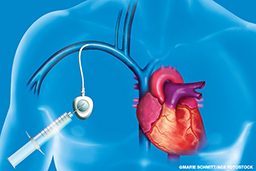Q: My wife, age 55, was diagnosed with a small internal carotid paraclinoid segment aneurysm. Her neurosurgeon says it is extradural and that there is no reason to limit her activities in any way. Is this condition compatible with recreational diving?
A: An aneurysm is a localized bulging of an artery caused by a weakness in the vessel’s wall. Aneurysms can occur in any blood vessel, and the degree of danger they pose is a function of size and location. As aneurysms enlarge, the risk of rupture increases. Their names are derived from the blood vessel from which they arise or anatomic location. In this case, the aneurysm is located on a branch or segment of the internal carotid artery, located outside the dura mater adjacent to the clinoid process — a bony prominence of the sphenoid bone that forms part of the cranial base.
The fact that this aneurysm is both small and in an extradural location is good news. The dura mater is a tough dual-layered membrane that covers the brain and spinal cord. In the event of a rupture, bleeding that occurs between the dura and the skull (extradural space) is easier to diagnose and treat, and poses a much smaller risk, than bleeding that occurs beneath the dura.
If your wife’s neurosurgeons are confident that physical activity poses no increased risk of rupture, there is no reason she cannot return to recreational diving. The unique physiological stress of diving is related to changes in pressure, and unlike air-filled spaces, those changes do not affect fluid-filled spaces like blood vessels.
A concern voiced by some divers is the potential of arterial bubble accumulation within the bulge of an aneurysm and the subsequent risk of gas expansion and possible vessel rupture on ascent. The true risk of this scenario is extremely small, and fortunately, the location and size of this particular aneurysm diminishes the potential consequences if rupture were to occur.
— DAN Medical Staff
Q: I had surgery on my left shoulder that included rotator cuff repair, acromioplasty and distal clavicle resection. How soon can I resume diving, and will the surgery put me at increased risk of decompression sickness (DCS)?
A: Acromioplasty and distal clavicle resection are relatively common procedures for repairing injured shoulders. They involve shaving the bones of the shoulder socket to improve functionality and decrease pain. A rotator cuff repair on top of this will generally prolong rehabilitation, and your surgeon will probably restrict you from engaging in strenuous activity for several months to allow for proper healing.

The first step toward a return to safe diving is clearance from your surgeon. This critical step, however, does not necessarily indicate a readiness to dive. To ensure optimal preparation, a return of physical strength and stability commensurate with tasks like lifting tanks and climbing boat ladders is advisable. From the viewpoint of dive safety, it is important to regain the strength and range of motion necessary to help yourself or others in an emergency.
From a diving medicine perspective, any condition or injury that compromises blood supply to the musculoskeletal system may impair inert gas uptake and elimination. For this reason, there is speculation about the possibility of an increased risk of DCS in the surgical site. However, this concern is theoretical and not supported by any published data.
Were a decompression hit to occur at the surgical site, it would not represent a significant risk to the surgical repair or impact long-term functionality. That said, recurring episodes of DCS in the same location may cause long-term complications, like pain and functional impairment and warrant additional medical evaluations for predisposing conditions as well as a review of dive practices. Medical evaluation for returning to diving in this event would likely involve studies to rule out osteonecrosis or serious limitations in strength and range of motion.
— Daniel A. Nord, BFA, EMT-P, CHT, director, DAN Medical Services
Q: I recently had a port implanted to facilitate the administration of medications. It is located in my chest just below my collar bone. Is it safe to dive with this device?
A: A port, sometimes called a Medi-Port or Port-a-Cath, is a small medical appliance surgically inserted under the skin to enable multiple administrations of medications or blood draws without the need for repeated intravenous catheter insertions. The device is about the size of a quarter and connects to the venous system, simplifying the treatment of hematology and oncology patients.

Ports are completely internal, so swimming and bathing do not pose a risk of infection. There are no gas-containing spaces within the device, so it is not subject to expansion or contraction with changes in depth. Most physicians agree ports are safe for divers when certain health concerns are taken into consideration.
The real concern is your underlying health. Many conditions that require a port — cancer, dialysis, cystic fibrosis and heart failure, to name a few — may place a diver at serious risk of injury. It is vital that you are medically cleared to participate in the sport. Prolonged illness can result in significant deconditioning, characterized by muscle weakness, early fatigue and limited endurance. Confirm with your treating physician that you are physically fit to dive. Special attention should be paid to ensure that any surgical sites are completely healed and not complicated by infection. In addition, review your medications and any expected side effects of treatment. For those undergoing chemotherapy, fatigue and exercise intolerance may be significant and should preclude diving.
Once cleared to dive, try on your equipment well ahead of your dive; some gear — BCD straps in particular — may rest or rub on the port area, causing discomfort. If any adjustments or adjuncts need to be made, such as adding padding to straps to reduce friction, give them the care and attention they deserve.
— John U. Lee, MSDT, EMT, CHT, DMT, DAN medical information specialist
© Alert Diver — Q1 Winter 2011